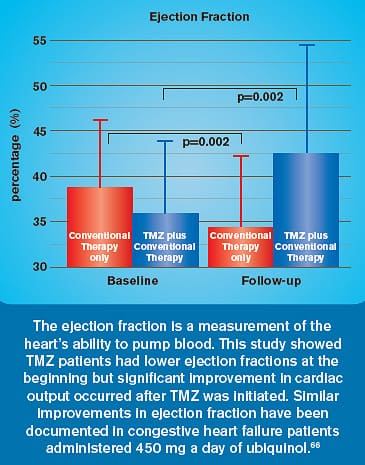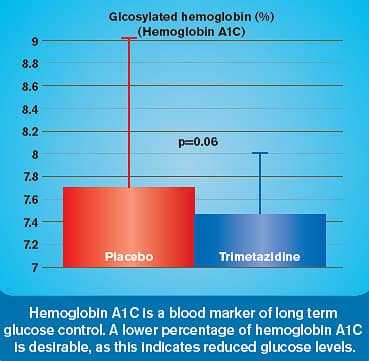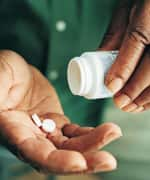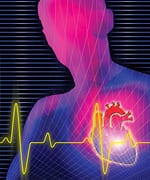Life Extension Magazine®
Over 82 million Americans are afflicted with some form of cardiovascular disease.1 It remains the number one cause of death in the US.1 Given this killer’s prevalence, you would think that medical officialdom would ensure maturing individuals have access to all available treatment options. You would be wrong. Despite over 40 years of published studies,2 a little-known, potentially lifesaving heart drug languishes in clinical and regulatory limbo in this country, a drug that Life Extension® espouses as a compelling target for further research and potential FDA approval. Available in more than 80 nations around the world, it is unlike any other conventional prescription medication for heart disease on the American market today. This drug is called as trimetazidine (TMZ). Also marketed as Vastarel MR in Europe, it modulates mitochondrial metabolism to energize and revive compromised heart tissue. A mountain of scientific research shows it has the capability to protect vulnerable, oxygen-deprived heart muscle before a lethal cardiac event takes place. In this article you will discover compelling evidence of trimetazidine’s cardioprotective power. You will learn of its capacity to reverse the deadly impact of diminished blood flow to the heart, the principal vascular pathology behind most heart attacks. Concerns about the lack of long-term data on hard endpoints like heart attack and cardiac mortality make the regulatory path to approval a difficult one for this novel drug. The arduous approval path for a new type of drug to help treat ischemic heart disease is an example of the need to cut burdensome bureaucratic mandates and stimulate the evaluation of better medications for heart disease. To understand how TMZ affords additional protection for at-risk heart muscle, we begin by outlining the significant limitations and dangers of conventional heart drugs. Many Medications But Only One Mode of ActionCardiac ischemia is the medical condition in which blood flow and therefore oxygen delivery to heart tissue is progressively limited, typically by arterial blockage; this is the origin of most heart attacks. Angina is its primary symptom—chest pain often accompanied by a sensation of uncomfortable pressure. Angina is the heart muscle crying out for more oxygen in order to perform its blood pumping function. It may surprise you to learn that while conventional drugs for cardiac ischemia and angina operate via different mechanisms of action, they induce only one physiological effect: they lower heart muscle demand for oxygen by improving blood flow and reducing cardiac workload.3 This approach may not be effective for all individuals with heart disease. The problem? These drugs do not restore heart tissue already damaged or dysfunctional back to peak efficiency. The powerhouses known as mitochondria in compromised heart muscle cells remain unable to optimally convert fuel into energy for maximum output.4 This may account for a chilling statistic: 88% of patients on conventional medications continue to suffer chronic angina and remain at risk of further cardiac complications.3 While enlightened individuals may support heart cell mitochondrial function using CoQ10 (ubiquionol),5 L-carnitine,6 taurine,7 magnesium,8 PQQ (pyrroloquinoline quinone)9 and other nutrients,10,11 most patients are not told about them by their cardiologist and optimal dosing seldom occurs. Furthermore, the drug TMZ functions via unique cytoprotective mechanisms to support left ventricular function through enhancing coronary blood flow. By shifting energy substrate utilization to glucose through inhibition of fatty acid metabolism, TMZ offers the potential to enhance cardiac muscle cell ATP levels through pathways that may not be attainable with nutrients alone.
Heart Protection Through a Unique and Powerful MechanismBy contrast to existing cardiac drugs, TMZ renders heart muscle optimally functional by enhancing energy output, as opposed to reducing workload.14 This fundamentally distinct mode of action offers aging individuals a complementary and potentially more effective way to ward off heart attack by enhancing the heart’s energy producing function rather than weakening the heart. This outcome is achieved via a novel mechanism of action: the metabolic pathway by which the heart converts fuel into energy is favorably altered. Here’s how it works: The mitochondria within your heart cells utilize fatty acids to generate the bulk of the energy that fuels heart function; in the presence of disease, the use of fatty acids increases.15 TMZ enables the mitochondria to utilize more glucose as a fuel source.16-18 This shift in heart cell metabolism affords benefits. To burn fatty acids, mitochondria require much more oxygen and produce more waste products than they do when glucose is the energy source.16,19,20 Under normal conditions that poses no problem, but ischemic heart tissue rapidly loses efficiency and accumulates acid as it continues to try to power itself from fat.21 By converting the preferred fuel source to glucose, fewer damaging acids are produced.16,20,22 Studies show that in the presence of TMZ, acid content in ischemic heart cells is much lower, and energy content is much higher, compared to controls.23-25 This results in faster recovery of heart muscle pumping action once blood flow is restored.26-28 TMZ treatment in animals with experimental ischemia has also been shown to reduce the size of the damaged area following complete blockage of a coronary artery, while improving the ability of the remaining heart muscle to pump blood.29-31 In addition, in both animal and human studies, TMZ treatment reduced the incidence of dangerous arrhythmias that frequently occur in the period following an ischemic event.32-35 Of equal importance, TMZ induces these beneficial effects with no negative impact on so-called “hemodynamics,” the delicate balance of heart rate, blood pressure, and heart muscle contractility that ultimately determines blood flow.16,36 This is in marked contrast to virtually all conventional drugs for angina and ischemia, which may produce potentially serious hemodynamic imbalances. In addition to these lifesaving effects, TMZ increases plasma levels of the heart-protecting compound adenosine in patients with angina. Adenosine is essential for cellular energy transfer. The result is called “preconditioning”: heart muscle develops a tolerance for limited blood flow instead of dying from it.16,37 TMZ also positively influences gene expression, increasing production of several signaling molecules involved in regulation of heart muscle contractility.16,38 Other signaling molecules involved in endothelial function are also favorably influenced by TMZ.16,39,40
Success in Clinical Studies Across Multiple Heart Health IndicatorsTMZ boasts an impressive track record in the acute management of both ischemic heart disease (the events leading up to a heart attack) and congestive heart failure (a major consequence of a heart attack).3,41 One of the earliest signs of ischemic heart disease is a change in electrocardiogram readings conducted during mild exercise. One such measure, known as “ST-segment depression,” indicates heart muscle lacking an adequate supply of oxygen to meet the demand of increased cardiac workload (ischemia). Several double-blind, placebo-controlled European studies showed that the addition of TMZ to a standard drug such as a beta blocker could prolong the time that patients could exercise before ST-segment depression appeared.42-44  Unlike ST-segment depression—which is asymptomatic and goes unnoticed in aging individuals with heart disease—the first noticeable sign of ischemia is chest pain or angina, which occurs when the heart muscle is under stress due to physical exertion, strong emotions or other factors. Multiple studies reveal that patients treated with TMZ experience fewer episodes of angina and a longer interval before angina onset in exercise tests compared to patients given placebo or other anti-angina drugs.42,45 In one particularly impressive study, 50 patients with stable angina were treated with the calcium blocker diltiazem with or without the addition of TMZ.44 A remarkable 68% of TMZ recipients experienced fewer angina attacks per week compared with baseline, while only 12% of the control group exhibited the same response. In still more advanced ischemia, patients eventually lose their ability to tolerate even mild exertion. Many studies demonstrate that TMZ can improve the duration of exercise in patients with ischemic heart disease and peripheral artery disease (“claudication”).44,46-48 Another measure of the severity of angina is the need for patients to use medications such as nitrates to relieve symptoms. Patients taking TMZ are often able to significantly reduce their nitrate intake.49 When we reduce the number of drugs a patient uses we also decrease the chance of adverse side effects as well as healthcare costs. Ischemic cardiomyopathy is the term for impaired heart muscle tissue with a reduced capacity to pump blood effectively. Through its beneficial shifts in cardiac metabolism, TMZ increases the amount of blood pumped by hearts of patients with severe ischemic cardiomyopathy, at the same time reducing the dysfunctional dilation of the heart’s pumping chambers (ventricles).40,47,50 After a heart attack and the accompanying loss of heart muscle, there is a sharp decrease in blood pumping ability that often persists after successful intervention. When TMZ is added to the drug regimen of patients undergoing common interventions such as cardiac catheterization and coronary artery bypass grafting, studies show improvements in left ventricular function.51-53 (See graph below.) Left ventricular function is in essence a measurement of the heart’s “horse power” i.e., its ability to fire on all cyclinders. TMZ also reduces the frequency of angina attacks during cardiac catheterization procedures and lowers markers of heart muscle damage during surgery.52,54  Heart failure often follows a heart attack, though it may develop as the result of chronic ischemia without an actual myocardial infarction. Heart failure occurs when the heart muscle is unable to meet the body’s metabolic demand for blood flow. Its symptoms include loss of exercise tolerance, difficulty breathing, and fluid buildup. The failing heart’s pumping chambers are enlarged and exhibit poor muscle contractility. Studies show that TMZ can improve these and other parameters of heart failure. Patients treated with TMZ exhibit enhanced left ventricular function associated with an increase in their heart muscle’s energy content.14 Patients with coronary artery disease who are given TMZ also experience favorable changes in heart wall thickness, pumping action, and oxygen delivery capacity, without unfavorable changes in heart rate or blood pressure.55 From the patients’ perspective, perhaps the most important index of improvement is how they feel and function in everyday life. Recent studies show that aside from medical parameters of heart health, TMZ improves quality of life in patients with heart disease.56 TMZ may also particularly benefit diabetics, given its power to induce heart muscle to utilize glucose. Human studies have shown significant decreases in glycosylated hemoglobin (HbA1c) in studies comparing TMZ with placebo in type 2 diabetics.17 Patients with diabetes have excessively high levels of circulating fats and their hearts are even more likely than those of normal patients to suffer the metabolic effects of fatty acid metabolism.15,16,40,57,58 More Long-Term Safety Data Needed for FDA ApprovalThe good news is that TMZ’s short-term safety profile has been well established in animal and human studies. Unlike conventional drugs, it has no detrimental effects on blood pressure or heart rate.16 Unfortunately, few studies have been conducted to determine TMZ’s safety profile with long-term use. Those that do exist offer conflicting evidence. On the positive side of the ledger, one 2009 study followed 153 patients taking TMZ for three years following coronary artery bypass surgery.59 They continued to show improvements in their hearts’ blood-pumping ability and in their exercise tolerance, as well as lower overall expenses for treatment, compared to controls. By contrast, ominous symptoms manifested in a 2011 report describing 21 patients who had been taking TMZ for several years.60 Seventeen of these patients had Parkinson’s disease-like symptoms, three had disturbances in range of motion while walking, and one had restless leg syndrome. Sixteen of these patients recovered normal function after going off TMZ, while the other five experienced significant reduction in symptoms after discontinuing TMZ. These results represent only a small fraction of the number of people taking TMZ worldwide. Nonetheless, clinical study of TMZ’s long-term safety is warranted. Without such studies this potentially lifesaving heart drug is unlikely to gain FDA approval.3 The need for long-term studies, however, should not preclude the short-term use of TMZ, which could save many American lives. SummaryOver 82 million Americans are afflicted with some form of cardiovascular disease. The majority of these individuals suffer limited blood flow to the heart (ischemia) resulting in chest pain (angina). Left untreated, ischemia progresses from cardiac muscle damage to heart attack. Conventional heart drugs have limited effectiveness against ischemic heart disease and produce undesirable side effects on heart rate, blood pressure, and other important parameters of heart health. TMZ is a unique drug that acts via a distinct mechanism of action, altering heart cell metabolism to utilize glucose instead of fat. TMZ has been shown to protect vulnerable or compromised heart muscle tissue from further ischemic damage in a variety of ways, including increased blood pumping action, heart muscle wall thickness, and energy content in heart muscle cells. Over 40 years of published studies from around the world support the use of TMZ in the management of ischemic heart disease and heart failure. A shortage of studies supporting safety of long-term use of TMZ is keeping this potential lifesaving heart drug from being available to Americans—even for short-term use!
If you have any questions on the scientific content of this article, please call a Life Extension® Health Advisor at 1-866-864-3027. | ||||||||||||||||||||||||||||||||||||||
| References | ||||||||||||||||||||||||||||||||||||||
| 1. Roger VL, Go AS, Lloyd-Jones DM, et al. Heart Disease and Stroke Statistics--2012 Update: A Report From the American Heart Association. Circulation. 2012 Jan 3;125(1):e2-e220. 2. Brodbin P, O’Connor CA. Trimetazidine in the treatment of angina pectoris. Br J Clin Pract. 1968 Sep;22(9):395-6. 3. Sack M. Clinical Implications: A Review of the Data. Advanced Studies in Medicine. 2004 November;4(108):S816-S21. 4. Ussher JR, Lopaschuk GD. Targeting malonyl CoA inhibition of mitochondrial fatty acid uptake as an approach to treat cardiac ischemia/reperfusion. Basic Res Cardiol. 2009 Mar;104(2):203-10. 5. Rosenfeldt FL, Pepe S, Linnane A, et al. Coenzyme Q10 protects the aging heart against stress: studies in rats, human tissues, and patients. Ann N Y Acad Sci. 2002 Apr;959:355-39; discussion 463-35. 6. Lango R, Smolenski RT, Narkiewicz M, Suchorzewska J, Lysiak-Szydlowska W. Influence of L-carnitine and its derivatives on myocardial metabolism and function in ischemic heart disease and during cardiopulmonary bypass. Cardiovasc Res. 2001 Jul;51(1):21-9. 7. Jeejeebhoy F, Keith M, Freeman M, et al. Nutritional supplementation with MyoVive repletes essential cardiac myocyte nutrients and reduces left ventricular size in patients with left ventricular dysfunction. Am Heart J. 2002 Jun;143(6):1092-100. 8. Cohen N, Alon I, Almoznino-Sarafian D,et al. Metabolic and clinical effects of oral magnesium supplementation in furosemide-treated patients with severe congestive heart failure. Clin Cardiol 2000 23(6):433-6. 9. Chowanadisai W, Bauerly KA, Tchaparian E, Wong A, Cortopassi GA, Rucker RB. Pyrroloquinoline quinone stimulates mitochondrial biogenesis through cAMP response element-binding protein phosphorylation and increased PGC-1 alpha expression. J Biol Chem. 2010 Jan 1;285:142-52. 10. Li CJ, Zhang QM, Li MZ, Zhang JY, Yu P, Yu DM. Attenuation of myocardial apoptosis by alpha-lipoic acid through suppression of mitochondrial oxidative stress to reduce diabetic cardiomyopathy. Chin Med J (Engl). 2009 Nov 5;122(21):2580-6. 11. Holub BJ. Clinical nutrition: 4. Omega-3 fatty acids in cardiovascular care. CMAJ. 2002 Mar 5;166(5):608-15. 12. Anderson JL, Adams CD, Antman EM, et al. 2011 ACCF/AHA Focused Update Incorporated Into the ACC/AHA 2007 Guidelines for the Management of Patients With Unstable Angina/Non-ST-Elevation Myocardial Infarction: a report of the American College of Cardiology Foundation/American Heart Association Task Force on Practice Guidelines. Circulation. 2011 May 10;123(18):e426-579. 13. Elliott WJ, Meyer PM. Incident diabetes in clinical trials of antihypertensive drugs: a network meta-analysis. Lancet. 2007 Jan 20;369(9557):201-7. 14. Fragasso G, Perseghin G, De Cobelli F, et al. Effects of metabolic modulation by trimetazidine on left ventricular function and phosphocreatine/adenosine triphosphate ratio in patients with heart failure. Eur Heart J. 2006 Apr;27(8):942-8. 15. Onay-Besikci A, Guner S, Arioglu E, Ozakca I, Ozcelikay AT, Altan VM. The effects of chronic trimetazidine treatment on mechanical function and fatty acid oxidation in diabetic rat hearts. Can J Physiol Pharmacol. 2007 May;85(5):527-35. 16. Onay-Besikci A, Ozkan SA. Trimetazidine revisited: a comprehensive review of the pharmacological effects and analytical techniques for the determination of trimetazidine. Cardiovasc Ther. 2008 Summer;26(2):147-65. 17. Fragasso G, Spoladore R, Cuko A, Palloshi A. Modulation of fatty acids oxidation in heart failure by selective pharmacological inhibition of 3-ketoacyl coenzyme-A thiolase. Curr Clin Pharmacol. 2007 Sep;2(3):190-6. 18. Grynberg A. Effectors of fatty acid oxidation reduction: promising new anti-ischaemic agents. Curr Pharm Des. 2005;11(4):489-509. 19. Available at: www.mims.com/USA/drug/info/trimetazidine%20hydrochloride/?q=anti-anginal%20drugs&type=full. Accessed November 15, 2011. 20. Kantor PF, Lucien A, Kozak R, Lopaschuk GD. The antianginal drug trimetazidine shifts cardiac energy metabolism from fatty acid oxidation to glucose oxidation by inhibiting mitochondrial long-chain 3-ketoacyl coenzyme A thiolase. Circ Res. 2000 Mar 17;86(5):580-8. 21. Folmes CD, Clanachan AS, Lopaschuk GD. Fatty acid oxidation inhibitors in the management of chronic complications of atherosclerosis. Curr Atheroscler Rep. 2005 Feb;7(1):63-70. 22. Mody FV, Singh BN, Mohiuddin IH, et al. Trimetazidine-induced enhancement of myocardial glucose utilization in normal and ischemic myocardial tissue: an evaluation by positron emission tomography. Am J Cardiol. 1998 Sep 3;82(5A):42K-49K. 23. Lavanchy N, Martin J, Rossi A. Anti-ischemic effects of trimetazidine: 31P-NMR spectroscopy in the isolated rat heart. Arch Int Pharmacodyn Ther. 1987 Mar;286(1):97-110. 24. Renaud JF. Internal pH, Na+, and Ca2+ regulation by trimetazidine during cardiac cell acidosis. Cardiovasc Drugs Ther. 1988 Mar;1(6):677-86. 25. El Banani H, Bernard M, Cozzone P, James F, Feuvray D. Ionic and metabolic imbalance as potential factors of ischemia reperfusion injury. Am J Cardiol. 1998 Sep 3;82(5A):25K-29K. 26. El Banani H, Bernard M, Baetz D, et al. Changes in intracellular sodium and pH during ischaemia-reperfusion are attenuated by trimetazidine. Comparison between low- and zero-flow ischaemia. Cardiovasc Res. 2000 Sep;47(4):688-96. 27. Aussedat J, Ray A, Kay L, Verdys M, Harpey C, Rossi A. Improvement of long-term preservation of isolated arrested rat heart: beneficial effect of the antiischemic agent trimetazidine. J Cardiovasc Pharmacol. 1993 Jan;21(1):128-35. 28. Kay L, Finelli C, Aussedat J, Guarnieri C, Rossi A. Improvement of long-term preservation of the isolated arrested rat heart by trimetazidine: effects on the energy state and mitochondrial function. Am J Cardiol. 1995 Aug 24;76(6):45B-49B. 29. Drake-Holland AJ, Belcher PR, Hynd J, Noble MI. Infarct size in rabbits: a modified method illustrated by the effects of propranolol and trimetazidine. Basic Res Cardiol. 1993 May-Jun;88(3):250-8. 30. Allibardi S, Chierchia SL, Margonato V, et al. Effects of trimetazidine on metabolic and functional recovery of postischemic rat hearts. Cardiovasc Drugs Ther. 1998 Dec;12(6):543-9. 31. Boucher FR, Hearse DJ, Opie LH. Effects of trimetazidine on ischemic contracture in isolated perfused rat hearts. J Cardiovasc Pharmacol. 1994 Jul;24(1):45-9. 32. Di Pasquale P, Lo Verso P, Bucca V, et al. Effects of trimetazidine administration before thrombolysis in patients with anterior myocardial infarction: short-term and long-term results. Cardiovasc Drugs Ther. 1999 Sep;13(5):423-8. 33. Kara AF, Demiryurek S, Celik A, Tarakcioglu M, Demiryurek AT. Effects of chronic trimetazidine treatment on myocardial preconditioning in anesthetized rats. Fundam Clin Pharmacol. 2006 Oct;20(5):449-59. 34. Kara AF, Demiryurek S, Celik A, Tarakcioglu M, Demiryurek AT. Effects of trimetazidine on myocardial preconditioning in anesthetized rats. Eur J Pharmacol. 2004 Oct 25;503(1-3):135-45. 35. Papadopoulos CL, Kanonidis IE, Kotridis PS, et al. The effect of trimetazidine on reperfusion arrhythmias in acute myocardial infarction. Int J Cardiol. 1996 Jul 26;55(2):137-42. 36. Belcher PR, Drake-Holland AJ, Hynd JW, Noble MI. Effects of trimetazidine on in vivo coronary arterial platelet thrombosis. Cardiovasc Drugs Ther. 1993 Feb;7(1):149-57. 37. Blardi P, de Lalla A, Volpi L, Auteri A, Di Perri T. Increase of adenosine plasma levels after oral trimetazidine: a pharmacological preconditioning? Pharmacol Res. 2002 Jan;45(1):69-72. 38. Morgan EE, Young ME, McElfresh TA, et al. Chronic treatment with trimetazidine reduces the upregulation of atrial natriuretic peptide in heart failure. Fundam Clin Pharmacol. 2006 Oct;20(5):503-5. 39. Monti LD, Allibardi S, Piatti PM, et al. Triglycerides impair postischemic recovery in isolated hearts: roles of endothelin-1 and trimetazidine. Am J Physiol Heart Circ Physiol. 2001 Sep;281(3):H1122-30. 40. Fragasso G, Piatti Md PM, Monti L, et al. Short- and long-term beneficial effects of trimetazidine in patients with diabetes and ischemic cardiomyopathy. Am Heart J. 2003 Nov;146(5):E18. 41. Belardinelli R, Solenghi M, Volpe L, Purcaro A. Trimetazidine improves endothelial dysfunction in chronic heart failure: an antioxidant effect. Eur Heart J. 2007 May;28(9):1102-8. 42. Szwed H, Sadowski Z, Elikowski W, et al. Combination treatment in stable effort angina using trimetazidine and metoprolol: results of a randomized, double-blind, multicentre study (TRIMPOL II). TRIMetazidine in POLand. Eur Heart J. 2001 Dec;22(24):2267-74. 43. Levy S. Combination therapy of trimetazidine with diltiazem in patients with coronary artery disease. Group of South of France Investigators. Am J Cardiol. 1995 Aug 24;76(6):12B-16B. 44. Manchanda SC. Treatment of stable angina with low dose diltiazem in combination with the metabolic agent trimetazidine. Int J Cardiol. 2003 Mar;88(1):83-9. 45. Manchanda SC, Krishnaswami S. Combination treatment with trimetazidine and diltiazem in stable angina pectoris. Heart. 1997 Oct;78(4):353-7. 46. Chazov EI, Lepakchin VK, Zharova EA, et al. Trimetazidine in Angina Combination Therapy--the TACT study: trimetazidine versus conventional treatment in patients with stable angina pectoris in a randomized, placebo-controlled, multicenter study. Am J Ther. 2005 Jan-Feb;12(1):35-42. 47. Di Napoli P, Di Giovanni P, Gaeta MA, D’Apolito G, Barsotti A. Beneficial effects of trimetazidine treatment on exercise tolerance and B-type natriuretic peptide and troponin T plasma levels in patients with stable ischemic cardiomyopathy. Am Heart J. 2007 Sep;154(3):602 e1-5. 48. Vitale C, Marazzi G, Pelliccia F, et al. Trimetazidine improves exercise performance in patients with peripheral arterial disease. Pharmacol Res. 2011 Apr;63(4):278-83. 49. Szwed H, Sadowski Z, Pachocki R, et al. The antiischemic effects and tolerability of trimetazidine in coronary diabetic patients. A substudy from TRIMPOL-1. Cardiovasc Drugs Ther. 1999 May;13(3):217-22. 50. Brottier L, Barat JL, Combe C, Boussens B, Bonnet J, Bricaud H. Therapeutic value of a cardioprotective agent in patients with severe ischaemic cardiomyopathy. Eur Heart J. 1990 Mar;11(3):207-12. 51. Peng JJ, Ma ZM, Ren WL, Ren LH, Lei LC, Liang Y. Clinical outcomes of trimetazidine in patients with acute ST segment elevation myocardial infarction without ST segment resolution after primary percutaneous coronary intervention. Zhonghua Yi Xue Za Zhi. 2009 May 26;89(20):1399-401. 52. Chen YD, Zhao LK, Tian F, Du ZM, Jiang H, Wei M. Evaluation of the myocardial protection of trimetazidine during percutaneous coronary intervention: a multi-center randomized and controlled clinical study. Zhonghua Nei Ke Za Zhi. 2010 Jun;49(6):473-6. 53. Fabiani JN, Ponzio O, Emerit I, et al. Cardioprotective effect of trimetazidine during coronary artery graft surgery. J Cardiovasc Surg (Torino). 1992 Jul-Aug;33(4):486-91. 54. Iskesen I, Kurdal AT, Eserdag M, Cerrahoglu M, Sirin BH. Trimetazidine may protect the myocardium during cardiac surgery. Heart Surg Forum. 2009 Jun;12(3):E175-9. 55. Belardinelli R, Purcaro A. Effects of trimetazidine on the contractile response of chronically dysfunctional myocardium to low-dose dobutamine in ischaemic cardiomyopathy. Eur Heart J. 2001 Dec;22(23):2164-70. 56. Marazzi G, Gebara O, Vitale C, et al. Effect of trimetazidine on quality of life in elderly patients with ischemic dilated cardiomyopathy. Adv Ther. 2009 Apr;26(4):455-61. 57. Fragasso G, Salerno A, Spoladore R, Cera M, Montanaro C, Margonato A. Effects of metabolic approach in diabetic patients with coronary artery disease. Curr Pharm Des. 2009;15(8):857-62. 58. Rosano GM, Vitale C, Fragasso G. Metabolic therapy for patients with diabetes mellitus and coronary artery disease. Am J Cardiol. 2006 Sep 4;98(5A):14J-18J. 59. Lopatin Iu M, Dronova EP. Clinical-pharmacoeconomic aspects of trimetazidine modified release use in patients with ischemic heart disease undergoing coronary artery bypass grafting. Kardiologiia. 2009;49(2):15-21. 60. Masmoudi K, Masson H, Gras V, Andrejak M. Extrapyramidal adverse drug reactions associated with trimetazidine: a series of 21 cases. Fundam Clin Pharmacol. 2011 Nov 2. 61. Masmoudi K, Masson H, Gras V, Andrejak M. Extrapyramidal adverse drug reactions associated with trimetazidine: a series of 21 cases. Fundam Clin Pharmacol. 2011 Nov 2. 62. Montastruc JL, Sommet A, Olivier P, et al. Drugs, Parkinson’s disease and parkinsonian syndroms: recent advances in pharmacovigilance. Therapie. 2006 Jan-Feb;61(1):29-38. 63. Masmoudi K, Gras-Champel V, Douadi Y, Masson H, Andrejak M. Trimetazidine-a new aetiology for extrapyramidal disorders: A case of parkinsonism and akathisia. Therapie. 2005 Nov-Dec;60(6):603-5. 64. Trimetazidine: new French pharmacovigilance data. Prescrire Int. 2010 Apr;19(106):74. 65. Marti Masso JF, Marti I, Carrera N, Poza JJ, Lopez de Munain A. Trimetazidine induces parkinsonism, gait disorders and tremor. Therapie. 2005 Jul-Aug;60(4):419-22. 66. Langsjoen PH, Langsjoen AM. Supplemental ubiquinol in patients with advanced congestive heart failure. Biofactors. 2008;32 (1-4):119-28. | ||||||||||||||||||||||||||||||||||||||





